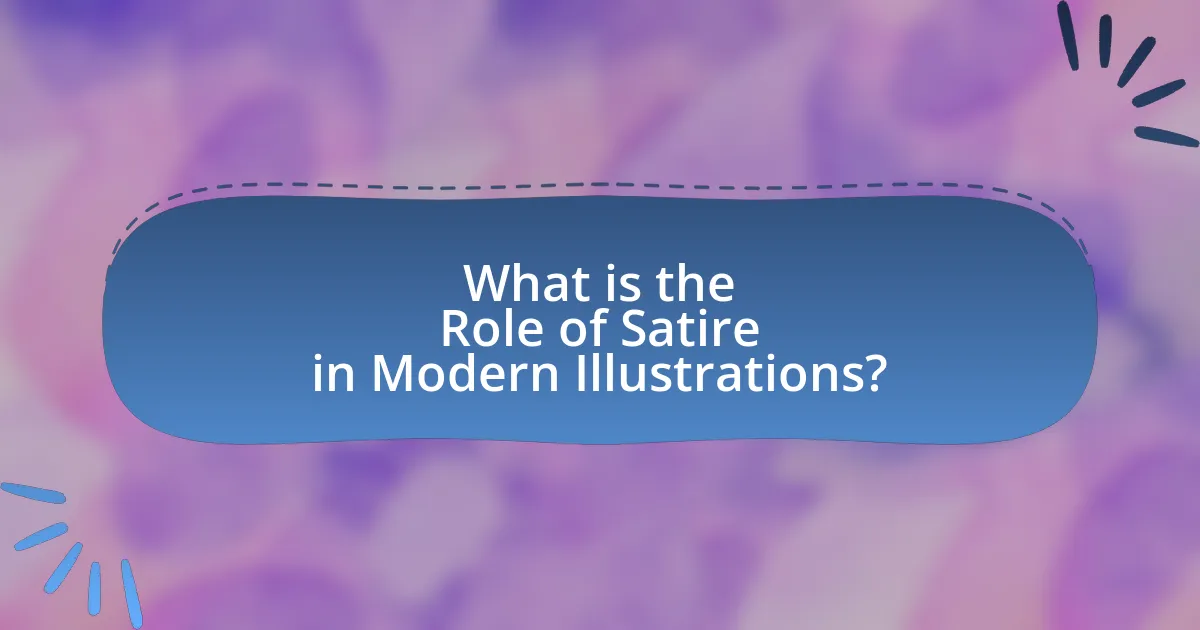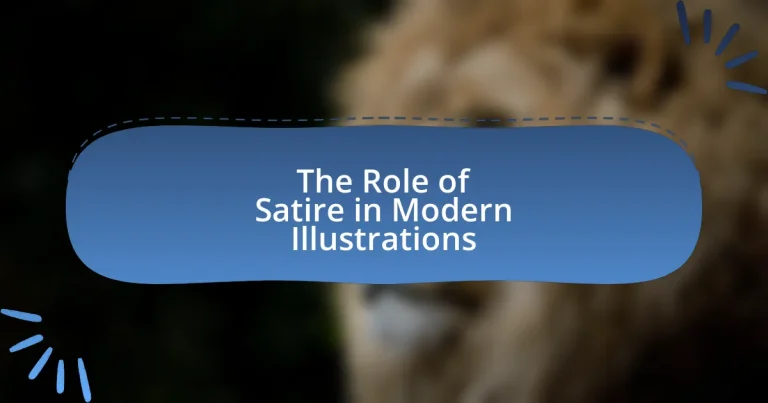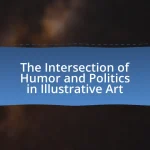The article examines the role of satire in modern illustrations, highlighting its significance as a tool for social commentary and political critique. It discusses how contemporary artists utilize humor, irony, and exaggeration to address societal issues, influence public perception, and engage audiences in critical discourse. Key elements of satire, such as exaggeration and parody, are explored, along with the challenges artists face, including misinterpretation and backlash. The article also emphasizes the importance of satire in reflecting societal changes and fostering critical thinking among viewers, while outlining best practices for artists to balance humor and sensitivity in their work.

What is the Role of Satire in Modern Illustrations?
Satire in modern illustrations serves as a critical tool for social commentary and political critique. By using humor and exaggeration, artists can highlight societal issues, challenge authority, and provoke thought among audiences. For instance, contemporary illustrators like Steve Bell and Barry Blitt utilize satire to address political events, effectively engaging viewers in discussions about governance and ethics. This approach not only entertains but also encourages reflection on complex topics, making satire a powerful medium in modern visual art.
How does satire influence the perception of modern illustrations?
Satire significantly influences the perception of modern illustrations by providing a critical lens through which societal norms and issues are examined. This form of artistic expression often employs humor, irony, and exaggeration to provoke thought and challenge the status quo, making complex subjects more accessible and engaging. For instance, political cartoons utilize satire to comment on current events, shaping public opinion and encouraging discourse. Research indicates that satirical illustrations can enhance audience engagement, as they invite viewers to reflect on the underlying messages and implications, thereby fostering a deeper understanding of the issues at hand.
What are the key elements of satire in illustrations?
The key elements of satire in illustrations include exaggeration, irony, parody, and social commentary. Exaggeration amplifies certain traits or behaviors to highlight absurdities, while irony contrasts expectations with reality to provoke thought. Parody mimics styles or subjects to critique them, and social commentary addresses societal issues, encouraging viewers to reflect on their implications. These elements work together to create a powerful critique of cultural norms and behaviors, making satire an effective tool in modern illustrations.
How does satire differ from other forms of commentary in illustrations?
Satire differs from other forms of commentary in illustrations by employing humor, irony, and exaggeration to critique societal norms or political issues. While traditional commentary may present straightforward opinions or observations, satire uses wit to provoke thought and highlight absurdities, often making the critique more impactful. For example, political cartoons often exaggerate the features of public figures to emphasize their flaws, a technique that distinguishes satire from more literal forms of illustration that may simply depict events or opinions without the same level of critical engagement. This unique approach allows satire to resonate emotionally with audiences, encouraging reflection and discussion on the subjects it addresses.
Why is satire important in contemporary visual culture?
Satire is important in contemporary visual culture because it serves as a powerful tool for social critique and commentary. By using humor and exaggeration, satire can effectively highlight societal issues, challenge norms, and provoke thought among audiences. For instance, political cartoons often use satire to address corruption or injustice, making complex topics more accessible and engaging. Research indicates that satirical content can enhance public discourse by encouraging critical thinking and fostering dialogue about pressing issues, as seen in studies published in the Journal of Communication, which demonstrate that audiences exposed to satirical media are more likely to engage with political content.
What social issues are commonly addressed through satirical illustrations?
Satirical illustrations commonly address social issues such as political corruption, inequality, environmental concerns, and social justice. These illustrations serve as a critique of societal norms and behaviors, often highlighting the absurdities and contradictions within these issues. For instance, political cartoons frequently depict government officials engaging in corrupt practices, thereby raising awareness about the need for accountability. Similarly, illustrations addressing inequality often showcase the disparity between different socioeconomic classes, prompting discussions about wealth distribution and social equity. Environmental issues are also prevalent, with artists using satire to comment on climate change and corporate negligence, thereby encouraging public discourse on sustainability. Social justice themes, including racism and gender inequality, are illustrated to provoke thought and inspire action among viewers.
How does satire engage audiences differently than traditional art forms?
Satire engages audiences differently than traditional art forms by using humor and irony to provoke critical thinking and social commentary. Unlike traditional art, which often aims to evoke aesthetic appreciation or emotional responses, satire directly challenges societal norms and encourages audiences to reflect on issues such as politics, culture, and morality. For example, works like Jonathan Swift’s “A Modest Proposal” employ exaggerated scenarios to highlight the absurdity of social injustices, prompting audiences to confront uncomfortable truths. This direct engagement fosters a more active participation in discourse, as satire often invites viewers to question and critique rather than passively consume.

What techniques are used in satirical illustrations?
Satirical illustrations employ techniques such as exaggeration, parody, caricature, and juxtaposition to convey humor and critique societal issues. Exaggeration amplifies certain features or behaviors to highlight absurdities, while parody imitates styles or works to mock them. Caricature distorts physical traits or characteristics of individuals to emphasize flaws, and juxtaposition places contrasting elements side by side to create irony or highlight contradictions. These techniques are effective in engaging audiences and provoking thought about the subjects being illustrated.
How do artists employ humor in their satirical works?
Artists employ humor in their satirical works by using exaggeration, irony, and absurdity to critique societal norms and behaviors. This approach allows them to highlight contradictions and provoke thought while entertaining the audience. For instance, political cartoons often exaggerate the features of public figures to emphasize their flaws, making the critique more impactful and memorable. Historical examples include the works of artists like Honoré Daumier, who used caricature to comment on social injustices in 19th-century France, demonstrating how humor can effectively convey serious messages.
What role does exaggeration play in satirical illustrations?
Exaggeration serves as a critical tool in satirical illustrations by amplifying characteristics or behaviors to highlight societal flaws or absurdities. This technique allows artists to create a stark contrast between reality and the depicted scenario, making the underlying message more impactful. For instance, political cartoons often exaggerate the features of public figures to critique their actions or policies, effectively drawing attention to issues that may otherwise be overlooked. Historical examples include the works of artists like Honoré Daumier, whose exaggerated portrayals of politicians in 19th-century France underscored the corruption and incompetence of the ruling class, demonstrating how exaggeration can provoke thought and discussion on important social topics.
How do visual metaphors enhance the effectiveness of satire?
Visual metaphors enhance the effectiveness of satire by providing immediate visual cues that convey complex ideas succinctly. These metaphors allow audiences to grasp the underlying message quickly, often eliciting emotional responses that reinforce the satirical commentary. For instance, a cartoon depicting a politician as a puppet can instantly communicate themes of manipulation and lack of authenticity, making the satire more impactful. Research indicates that visual elements can increase retention and understanding of messages, as seen in studies by Brigham Young University, which found that visuals significantly improve comprehension and recall in communication. Thus, visual metaphors serve as powerful tools in satire, amplifying its reach and resonance with viewers.
What are the challenges faced by artists using satire?
Artists using satire face several challenges, including misinterpretation of their work, backlash from audiences, and the risk of censorship. Misinterpretation occurs when the intended humor or critique is not understood, leading to confusion or offense. Backlash can arise from individuals or groups who feel targeted or insulted by the satire, potentially resulting in public outrage or threats. Censorship poses a significant risk, as artists may face restrictions from platforms or institutions that fear controversy or legal repercussions. These challenges highlight the delicate balance artists must maintain between expressing their viewpoints and navigating societal sensitivities.
How can satire be misinterpreted by audiences?
Satire can be misinterpreted by audiences when the intended humor or critique is not recognized, leading to confusion or offense. This misinterpretation often occurs due to cultural differences, lack of context, or varying levels of familiarity with the subject matter being satirized. For instance, a satirical piece that targets a specific political issue may be misunderstood by individuals who are not well-versed in that political context, resulting in a literal interpretation rather than an appreciation of the underlying commentary. Additionally, satire that employs irony or exaggeration can be particularly susceptible to misinterpretation, as audiences may take the exaggerated elements at face value instead of recognizing them as a form of critique.
What are the risks of backlash against satirical illustrations?
The risks of backlash against satirical illustrations include public outrage, censorship, and potential violence. Public outrage can arise when individuals or groups perceive the satire as offensive or disrespectful, leading to widespread condemnation and calls for accountability. Censorship may occur as platforms or publishers choose to remove or restrict access to the illustrations to avoid controversy, limiting artistic expression. Additionally, there is a risk of violence, as seen in incidents where satirical content has provoked extreme reactions, such as the 2015 Charlie Hebdo attack, highlighting the potential dangers faced by creators of satirical works.

How does satire in modern illustrations reflect societal changes?
Satire in modern illustrations reflects societal changes by critiquing contemporary issues and highlighting cultural shifts. For instance, political cartoons often address topics such as climate change, social justice, and economic inequality, using humor and exaggeration to provoke thought and discussion. This form of illustration serves as a mirror to society, revealing public sentiment and the evolving landscape of values. Research indicates that satire can influence public opinion; a study published in the Journal of Communication found that satirical content can increase awareness and engagement with social issues. Thus, modern illustrations not only entertain but also play a crucial role in shaping societal discourse.
What trends in society are mirrored in satirical illustrations?
Satirical illustrations mirror several societal trends, including political corruption, social inequality, and cultural absurdities. For instance, political cartoons often depict leaders in exaggerated manners to highlight their failings, reflecting public discontent with governance. Additionally, illustrations addressing social inequality showcase disparities in wealth and opportunity, resonating with movements like Black Lives Matter and the fight for economic justice. Cultural absurdities are also prevalent, as artists critique consumerism and technology’s impact on human interaction, evident in works that parody social media culture. These trends are validated by the consistent presence of such themes in contemporary satirical art, demonstrating its role as a commentary on current societal issues.
How do current events shape the themes of satire in illustrations?
Current events significantly shape the themes of satire in illustrations by providing relevant context and subject matter that artists can critique. For instance, political scandals, social movements, and global crises often serve as focal points for satirical commentary, allowing illustrators to reflect public sentiment and provoke thought. A notable example is the use of illustrations during the COVID-19 pandemic, where artists highlighted issues such as government response and public health misinformation, effectively using satire to engage audiences and stimulate discussion. This connection between current events and satire ensures that illustrations remain timely and resonate with viewers, reinforcing the role of satire as a tool for social critique and reflection.
What historical contexts influence modern satirical illustrations?
Modern satirical illustrations are influenced by historical contexts such as the political upheavals of the French Revolution, the social critiques of the Victorian era, and the rise of mass media in the 20th century. The French Revolution (1789-1799) saw artists like James Gillray use satire to comment on political corruption and social injustice, establishing a precedent for using humor as a tool for critique. The Victorian era (1837-1901) further developed this tradition, with publications like Punch magazine employing satire to address societal norms and politics, reflecting public sentiment and influencing contemporary views. Additionally, the advent of mass media in the 20th century, particularly through cartoons and comic strips, allowed for broader dissemination of satirical content, shaping public discourse and enabling artists to respond quickly to current events. These historical contexts collectively inform the techniques and themes present in modern satirical illustrations, demonstrating the enduring power of satire as a form of social commentary.
What are the implications of satire for artists and audiences?
Satire serves as a critical tool for artists and audiences, enabling them to engage with societal issues through humor and irony. For artists, satire allows for creative expression that challenges norms and provokes thought, often leading to social commentary that can influence public opinion. For audiences, satire provides a lens to reflect on their own beliefs and societal structures, fostering critical thinking and dialogue. Historical examples, such as Jonathan Swift’s “A Modest Proposal,” illustrate how satire can effectively highlight social injustices, prompting audiences to reconsider their perspectives. Thus, the implications of satire are profound, as it shapes both artistic expression and audience engagement with critical societal themes.
How can satire foster critical thinking among viewers?
Satire fosters critical thinking among viewers by challenging societal norms and encouraging skepticism towards accepted beliefs. Through humor and exaggeration, satire highlights contradictions and absurdities in political, social, and cultural contexts, prompting viewers to question the status quo. For instance, shows like “The Daily Show” and “Saturday Night Live” use satire to critique political figures and policies, which can lead audiences to analyze and reflect on real-world issues more deeply. Research indicates that exposure to satirical content can enhance critical thinking skills by stimulating discussions and promoting a more analytical approach to information consumption.
What responsibilities do artists have when creating satirical content?
Artists have the responsibility to ensure that their satirical content is both thought-provoking and respectful, avoiding the reinforcement of harmful stereotypes or misinformation. This responsibility stems from the potential impact satire can have on public perception and discourse, as illustrated by historical examples where satirical works have influenced social movements or public opinion. For instance, the satirical cartoons of the early 20th century played a significant role in shaping attitudes towards political issues, demonstrating that artists must navigate the fine line between critique and offense. Therefore, artists should strive for a balance that encourages critical thinking while being mindful of the societal implications of their work.
What best practices should artists follow when creating satirical illustrations?
Artists should prioritize clarity and relevance when creating satirical illustrations. Clear messaging ensures that the satire is easily understood by the audience, while relevance connects the illustration to current events or societal issues, enhancing its impact. For instance, the use of recognizable symbols or figures can effectively convey the intended critique, as seen in the works of artists like Honoré Daumier, who used caricature to comment on political issues in 19th-century France. Additionally, artists should maintain a balance between humor and seriousness to avoid trivializing important topics, as effective satire often provokes thought rather than mere laughter.
How can artists balance humor and sensitivity in their work?
Artists can balance humor and sensitivity in their work by carefully considering their audience and the context of their subject matter. This involves understanding the cultural and social implications of their humor, ensuring that it does not perpetuate stereotypes or offend marginalized groups. For instance, successful comedians and satirists often employ techniques such as self-deprecation or absurdity to diffuse potentially sensitive topics, allowing for humor that invites reflection rather than alienation. Research indicates that humor can foster connection and understanding when it is inclusive and empathetic, as seen in the works of artists like Jon Stewart and John Oliver, who address serious issues with a blend of wit and respect.
What strategies can enhance the impact of satirical illustrations?
To enhance the impact of satirical illustrations, artists should employ clear messaging, cultural relevance, and emotional engagement. Clear messaging ensures that the satire is easily understood, allowing the audience to grasp the intended critique without confusion. Cultural relevance connects the illustration to current events or societal issues, making it more relatable and impactful. Emotional engagement, achieved through humor or provocation, encourages the audience to reflect on the subject matter, fostering a deeper connection and prompting discussion. These strategies are supported by studies indicating that illustrations that resonate with viewers’ experiences and emotions are more likely to be shared and discussed, amplifying their reach and influence.


